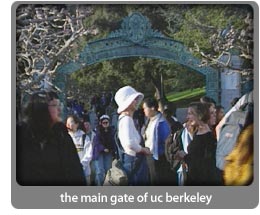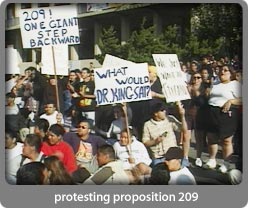 | 
The crown jewel of the University of California system, Berkeley is arguably one
of the most selective public universities in the country. In 1999, it denied over
70 percent of its applicants. But the competition to get into the University of
California's flagship campus wasn't always so steep. Before 1960, 15 percent of
California's high school graduates were eligible to attend the school, and until
1964, the school admitted anyone who met its requirements. But competition
increased after the 1960 adoption of the Master Plan for Higher Education in
California, spearheaded by then president of the University of California system,
Clark Kerr.
 In the late 1950s, California's population was growing by 500,000
people a year. Kerr foresaw massive growth in the state's higher education
system, and convened a series of committees to draft a plan to deal with that
growth. The members of the groups were weighted to favor the University of
California's interests over those of the state colleges (which later became the
California State University system), which Kerr saw as a threat to the university
system's elite status.
In the late 1950s, California's population was growing by 500,000
people a year. Kerr foresaw massive growth in the state's higher education
system, and convened a series of committees to draft a plan to deal with that
growth. The members of the groups were weighted to favor the University of
California's interests over those of the state colleges (which later became the
California State University system), which Kerr saw as a threat to the university
system's elite status.
The result was a plan that almost entirely limited the
state colleges from granting Ph.D degrees, thus setting up a two-tier educational
system. The University of California schools would continue to be the main
research institutions in the state, attracting better faculty and more qualified
students, while the state colleges would provide the public service of a college
education for anyone who wanted it. Most importantly, the plan tightened
admissions requirements for the university system, admitting only the top 12.5
percent of the state's high school graduates.
In 1964, at the peak of the
civil rights movement, Berkeley instituted its Education Opportunity Program to
bring in more students from disadvantaged minority groups. Under the master plan,
the university could select up to two percent of its incoming freshman from the
pool of applicants who did not meet its eligibility requirements. Though this
loophole was probably added to the plan to allow the schools to stay athletically
competitive, Berkeley partially used it to admit low-income and minority students
that otherwise wouldn't have been accepted.
In 1967--20 years after the
Educational Testing Service opened its first west-coast office in Berkeley--the
University of California began requiring all applicants to take the SAT, a move
that further tightened eligibility requirements at Berkeley. Because of the gap
between the test scores of white applicants and black and Latino applicants, this
policy would obviously reduce the number of black and Latino students at the
school. To compensate, the university doubled its exception to eligibility
requirements, from two percent to four percent, for applicants "whose ethnic or
economic background had disadvantaged them." Later, in 1979, the university
raised that percentage to six percent.
Throughout the 1970s, competition for
admission at Berkeley gradually increased. By the early 80s, the school was
denying nearly half of its applicants, and by the end of that decade, it was
denying almost two thirds of those who applied. As the competition increased, so
did complaints about the school's admissions process.
In November of 1988,
the U.S. Department of Education's Office of Civil Rights announced that it was
investigating admissions procedures at Berkeley after receiving complaints that
the school was capping admissions of Asian students. As far back as the 60s, the
Asian presence on campus had always been strong, and Asian admits rose
dramatically throughout the 70s.
But during the next decade, statistics
showed a sharp drop in the percentage of Asian admissions, even though a higher
percentage of these applicants met Berkeley's standards than those from other
racial groups. Critics blamed the drop on the school's subjective admissions
policies, which they said placed too much weight on extracurricular activities.
In April of 1989, Berkeley Chancellor Ira Michael Heyman publicly apologized
for the drop in Asian admissions at the school. Though he denied that policies
had been put in place to deliberately restrict Asians, he vowed to make changes
to correct the error. In May, the University announced changes to admissions
standards that placed more emphasis on academic achievement, and agreed to make
its admissions process public for the first time. In the freshman class of 1991,
Asian students outnumbered whites for the first time in the school's history.
Four years later, affirmative action programs at all University of California
campuses came under fire. At the end of 1994, California Governor Pete Wilson
told reporters he favored ending race- and gender-based preferences in government
employment and college admissions. Weeks later, on January 19, 1995, University
of California Board of Regents member Ward Connerly announced he would work to
replace the university's affirmative action programs with "somethingä that is
fair." Eventually Connerly and Wilson worked together to bring the issue before
the entire board.
On July 20, 1995, after 12 hours of heated debate, the
board of regents voted 15-10 to end race based preferences in admissions, hiring
and contracting. (The ban went into effect in 1996 at graduate and professional
schools, and in 1998 in the undergraduate division.)
 The following year,
California voters supported Wilson and Connerly on ending race based admissions.
On November 5, 1996, 54 percent of the electorate voted 'yes' on Proposition
209--a ballot initiative banning all affirmative action in government employment
and public education. The American Civil Liberties Union challenged 209, but the
Ninth Circuit Court of Appeals upheld the law in April, 1997. The U.S. Supreme
Court later declined to hear the ACLU's appeal.
The following year,
California voters supported Wilson and Connerly on ending race based admissions.
On November 5, 1996, 54 percent of the electorate voted 'yes' on Proposition
209--a ballot initiative banning all affirmative action in government employment
and public education. The American Civil Liberties Union challenged 209, but the
Ninth Circuit Court of Appeals upheld the law in April, 1997. The U.S. Supreme
Court later declined to hear the ACLU's appeal.
The ban on affirmative action
had a drastic effect at Berkeley. In 1998, its first year without affirmative
action in undergraduate admissions, the school admitted its least diverse
freshman class in over 17 years, accepting 56 percent fewer African Americans and
49 percent fewer Latinos than in 1997.
At the beginning of the Fall 1998 semester, Berkeley further refined it admissions process, switching entirely to a
holistic approach of reviewing applications. In the previous year, the school
admitted 50 percent of its students based on their test scores, grade point
average and advanced placement credits, while admitting the other 50 percent
based on a comprehensive review of the entire application. In 1999, admissions
officers thoroughly reviewed all of the applications it received, taking into
account essays and personal information as well as academics and test scores.
After the change in admissions procedures, the number of black and Latino admits
rose slightly.

home |
discussion |
who got in? |
interviews |
the race issue |
sat & test prep |
history of the sat
the screening process |
test score gap |
getting in to berkeley |
bibliography |
links |
tapes & transcripts |
press |
links
FRONTLINE |
pbs online |
wgbh
 |  |